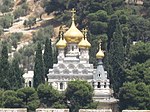Tomb of Absalom

The Tomb of Absalom (Hebrew: יד אבשלום, romanized: Yad Avshalom, lit. 'Absalom's Memorial'), also called Absalom's Pillar, is an ancient monumental rock-cut tomb with a conical roof located in the Kidron Valley in Jerusalem, a few metres from the Tomb of Zechariah and the Tomb of Benei Hezir. Although traditionally ascribed to Absalom, the rebellious son of King David of Israel (circa 1000 BC), recent scholarship has dated it to the 1st century AD. The tomb is not only a burial structure in its own right, with its upper part serving as a nefesh (funeral monument) for the tomb in its lower part, but it was probably also meant as a nefesh for the adjacent burial cave system known as the Cave or Tomb of Jehoshaphat, with which it forms one entity, built at the same time and following a single plan.The freestanding monument contains a burial chamber with three burial sites. The chamber is carved out of the solid lower section of the monument, but can only be accessed from the upper section via a built entrance and a staircase. It has been compared to Petra, given the rock-cut nature of the bottom segment and the style of the finial.
Excerpt from the Wikipedia article Tomb of Absalom (License: CC BY-SA 3.0, Authors, Images).Tomb of Absalom
ליד אבשלום, Jerusalem Ras al-Amud
Geographical coordinates (GPS) Address Nearby Places Show on map
Geographical coordinates (GPS)
| Latitude | Longitude |
|---|---|
| N 31.776958333333 ° | E 35.238958333333 ° |
Address
קבר רבי חיים בן עטר
ליד אבשלום
9114001 Jerusalem, Ras al-Amud
Jerusalem District, Israel
Open on Google Maps










